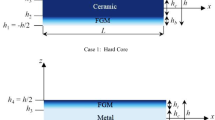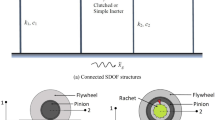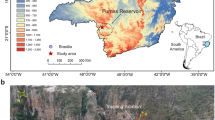Field investigations of earthquake-stricken areas have shown that eccentric structures usually suffer more severe seismic damage than symmetric structures due to translational-torsional coupling. While most studies have focused on the torsional response of single-layer or unidirectional eccentric structures, this paper presents a whole-process parametric analysis of the translational-torsional coupling effect of the multilayer bidirectional eccentric frame structure. Next, a nonlinear static analysis is performed via a self-compiled MATLAB program, revealing a general law for the variation in the natural frequency of the multilayer eccentric frame structure in different layers during its evolution from the elastic to the elastoplastic stage. This process is subdivided into three distinct analytic stages. The parametric analysis is also performed for the translational-torsional displacement ratio varying with the noncoupled torsional-translational frequency ratio (Ω) and the bidirectional eccentricity (bx, by) throughout the three stages. The analysis shows that the translational-torsional coupling effect of the bidirectional eccentric structure was most intense at Ω = 1.1. This is a very adverse situation that may occur in the torsion-resistant design of the structure and deserves extra attention. The translational-torsional coupling effect is aggravated along the load (x) direction as it increases and is unaffected by bx, Ω, or the elastoplastic development process. The degree of influence of bx on the translational-torsional coupling effect depends on which particular layer of the structure is under consideration and the elastoplastic development process. As elastoplastic development proceeds, the translational motion of the structure along the load direction finally predominates. Meanwhile, the translational-torsional coupling effect along the load direction decreases dramatically.












Similar content being viewed by others
References
M. A. Kewalramani and Z. I. Syed, “Seismic analysis of torsional irregularity in multi-storey symmetric and asymmetric buildings,” Eurasian J Anal Chem, 13, No. 3, 286–292 (2017).
K, K, Sneha and J. Durgaprasad, “An investigation of coefficient of torsional irregularity for irregular buildings in plan,” Lect Notes Civil Eng, 162, 637–656 (2022).
K. M. Alaa, K. F. El-Kashif, and H. M. Salem, “New definition for torsional irregularity based on floor rotations of reinforced concrete buildings,” J Eng Appl Sci, 69, No. 1, 1–35 (2022).
R. Hejal and A. K. Chopra, “Lateral-torsional coupling in earthquake response of frame buildings,” J Struct Eng, 115, No. 4, 852–867 (1989).
J. L. Humar and P. Kumar, “Torsional motion of buildings during earthquakes. I. Elastic response,” Canadian J Civil Eng, 25, No. 5, 898–916 (1998).
M. N. Bugeja, D. P. Thambiratnam, and G. H. Brameld, “The influence of stiffness and strength eccentricities on the inelastic earthquake response of asymmetric structures,” Eng Struct, 21, No. 9, 856–863 (1999).
W. K. Tso and Y. Bozorgnia, “Effective eccentricity for inelastic seismic response of building,” Earthq Eng Struct D, 14, No. 3, 413–427 (1986).
J. L. Humar and P. Kumar, “Effect of orthogonal inplane structural elements on inelastic torsional response,” Earthq Eng Struct D, 28, No. 10, 1071–1097 (1999).
G. K. Georgoussis and A. Mamou, “The effect of mass eccentricity on the torsional response of building structures,” Struct Eng Mech, 67, No. 6, 671–682 (2018).
M. S. Mehana, O. Mohamed, and F. Isam, “Torsional behaviour of irregular buildings with single eccentricity,” IOP Conf Ser Mater Sci Eng, 603, 1–10 (2019).
X. L. Jiang and Y. P. Kuang, “Inelastic parametric analysis of two-way asymmetrical multi-storey buildings,” Adv Struct Eng, 19, No. 5, 806–824 (2016).
Y. P. Kuang and Y. S. Liu, “Parametric analysis of the whole loading process of translation-torsion coupled vibration characteristics of the multilayer bidirectional eccentric frame structure,” J Theor Appl Mech, 60, No. 3, 479–494 (2022).
S. A. Raheem, M. M. Ahmed, M. M. Ahmed, and A. A. Abdel-Shafy, “Seismic performance of l-shaped multistorey buildings with moment-resisting frames,” in: P I Civil Eng-Str B, 171, No. 5, 395–408 (2018).
S. A. Raheem, M. M. Ahmed, M. M. Ahmed, and A. A. Abdel-Shafy, “Evaluation of plan configuration irregularity effects on seismic response demands of L-shaped MRF buildings,” B Earthq Eng, 16, No. 9, 3845–3869 (2018).
B. Khanal and H. Chaulagain, “Study of seismic response demands of different L-shaped buildings,” Himalayan J Appl Sci Eng, 1, No. 1, 22–29 (2020).
R. Hejal and A. K. Chopra, “Lateral-torsional coupling in earthquake response of frame buildings,” J Struct Eng, 115, No. 4, 852–867 (1989).
A. M. Chandler and X. N. Duan, “A modified static procedure for the design of torsionally unbalanced multistorey frame buildings,” Earthq Eng Struct D, 22, No. 5, 447–462 (1993).
S. A. Raheem, M. Omar, A. A. Zaher, and A. Taha, “Effects of numerical modeling simplification on seismic design of buildings,” Coupled Syst Mec, 7, No. 6, 731–753 (2018).
J. Han, Y. Pan, B. T. Yang, and Y. C. Han, “Rule of torsional response of the multi-storey asymmetrical eccentric frame structure under earthquake action [in Chinese],” China Civil Eng J, 46, No. S1, 69–74 (2013).
Y. P. Kuang, X. L. Jiang, and N. Jiang, “Inelastic parametric analysis of seismic responses of multi-storey bidirectional eccentric structure,” Shock Vib, 2018, 7023205 (2018). https://doi.org/https://doi.org/10.1155/2018/7023205
A. K. Chopra, Dynamics of Structures. Theory Applications to Earthquake Engineering, Pearson Prentice Hall, New Jersey, USA (2007).
W. H. Wu and H. A. Smith, “Efficient modal analysis for structures with soil-structure interaction,” Earthq Eng Struct D, 24, No. 2, 283–299 (1995).
Z. He and J. P. Ou, Non-Linear Analysis of Reinforced Concrete Structures [in Chinese], Harbin Institute of Technology Press, Harbin (2007).
Y. Li and X. L. Jiang, “Parametric analysis of eccentric structure-soil interaction system based on branch mode decoupling method,” Earthq Eng Struct D, 48, 63–70 (2013).
C. L. Kan and A. K. Chopra, “Torsional coupling and earthquake response of single elastic and inelastic systems,” J Struct Div, 107, No. 8, 1569–1588 (1981)
Acknowledgment
The research was supported by the High-level Talents Project of North China University of Water Resources and Electric Power (201803003).
Author information
Authors and Affiliations
Corresponding author
Additional information
Translated from Problemy Mitsnosti, No. 4, p. 122, July – August, 2023
Rights and permissions
Springer Nature or its licensor (e.g. a society or other partner) holds exclusive rights to this article under a publishing agreement with the author(s) or other rightsholder(s); author self-archiving of the accepted manuscript version of this article is solely governed by the terms of such publishing agreement and applicable law.
About this article
Cite this article
Kuang, Y.P., Liu, Y.S. Parametric Analysis of the Translational-Torsional Displacement Ratio in the Multilayer Bidirectional Eccentric Frame Structure at the Elastoplastic Stage. Strength Mater 55, 841–854 (2023). https://doi.org/10.1007/s11223-023-00575-8
Received:
Published:
Issue Date:
DOI: https://doi.org/10.1007/s11223-023-00575-8




